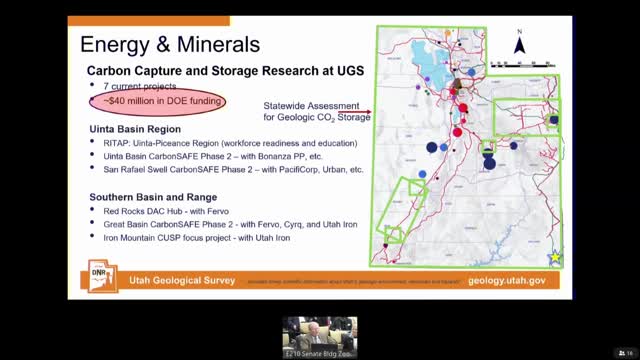Utah seeks $4.3M for geothermal research amid federal funding concerns
January 23, 2025 | 2025 Utah Legislature, Utah Legislature, Utah Legislative Branch, Utah
This article was created by AI summarizing key points discussed. AI makes mistakes, so for full details and context, please refer to the video of the full meeting. Please report any errors so we can fix them. Report an error »

In a pivotal meeting held on January 23, 2025, the Natural Resources, Agriculture, and Environmental Quality Appropriations Subcommittee of the Utah State Legislature gathered to discuss pressing issues surrounding funding and resource management. The atmosphere was charged with concern as members addressed the potential decrease in federal funding, particularly highlighting a significant $40 million allocation from the Department of Energy that may be at risk due to project delays.
The discussion revealed that ongoing carbon capture and sequestration projects, which involve partnerships with local universities and businesses, are facing uncertainty. Plans for the next two years have already been put on hold, raising alarms about the future of these initiatives and the potential loss of $1 million in funding. While contracts for current projects remain intact, the looming threat of reduced federal support has left committee members anxious about the implications for state resources.
Utah's commitment to mapping and geological surveys was also a focal point, with the state ranking third in the nation for funding in this area. The committee reported a robust increase in public engagement, with website traffic for geothermal and energy resources surging by 42% and 68%, respectively. This growing interest underscores the importance of transparency and accessibility in sharing information about Utah's natural resources.
However, the meeting also highlighted significant financial challenges. Approximately half of the funding for the department comes from general funds, with a third from federal sources. The committee expressed concerns over the volatility of mineral lease revenues, which have seen a drastic decline due to reduced production on federal lands. This instability has created a budget shortfall, prompting discussions about the need for a "rainy day" fund established by Senate Bill 133 in 2021. The committee is now seeking approval to access up to $700,000 from this reserve to mitigate the financial strain.
In a bid to stabilize funding, committee members proposed increasing the percentage of severance tax collected, which currently stands at 2.5%. A proposed adjustment to 4% or 5% could provide much-needed relief and enhance the department's financial resilience.
As the meeting drew to a close, the governor's recommendation for an additional $4.3 million to advance geothermal research emerged as a beacon of hope. This funding could play a crucial role in bolstering Utah's renewable energy initiatives and addressing the challenges posed by fluctuating federal support.
The discussions at this meeting reflect a critical juncture for Utah's natural resources management, as the state grapples with funding uncertainties while striving to maintain its commitment to sustainable practices and innovative research. The outcomes of these deliberations will undoubtedly shape the future of Utah's environmental landscape and its ability to respond to the evolving demands of its citizens.
The discussion revealed that ongoing carbon capture and sequestration projects, which involve partnerships with local universities and businesses, are facing uncertainty. Plans for the next two years have already been put on hold, raising alarms about the future of these initiatives and the potential loss of $1 million in funding. While contracts for current projects remain intact, the looming threat of reduced federal support has left committee members anxious about the implications for state resources.
Utah's commitment to mapping and geological surveys was also a focal point, with the state ranking third in the nation for funding in this area. The committee reported a robust increase in public engagement, with website traffic for geothermal and energy resources surging by 42% and 68%, respectively. This growing interest underscores the importance of transparency and accessibility in sharing information about Utah's natural resources.
However, the meeting also highlighted significant financial challenges. Approximately half of the funding for the department comes from general funds, with a third from federal sources. The committee expressed concerns over the volatility of mineral lease revenues, which have seen a drastic decline due to reduced production on federal lands. This instability has created a budget shortfall, prompting discussions about the need for a "rainy day" fund established by Senate Bill 133 in 2021. The committee is now seeking approval to access up to $700,000 from this reserve to mitigate the financial strain.
In a bid to stabilize funding, committee members proposed increasing the percentage of severance tax collected, which currently stands at 2.5%. A proposed adjustment to 4% or 5% could provide much-needed relief and enhance the department's financial resilience.
As the meeting drew to a close, the governor's recommendation for an additional $4.3 million to advance geothermal research emerged as a beacon of hope. This funding could play a crucial role in bolstering Utah's renewable energy initiatives and addressing the challenges posed by fluctuating federal support.
The discussions at this meeting reflect a critical juncture for Utah's natural resources management, as the state grapples with funding uncertainties while striving to maintain its commitment to sustainable practices and innovative research. The outcomes of these deliberations will undoubtedly shape the future of Utah's environmental landscape and its ability to respond to the evolving demands of its citizens.
View full meeting
This article is based on a recent meeting—watch the full video and explore the complete transcript for deeper insights into the discussion.
View full meeting

